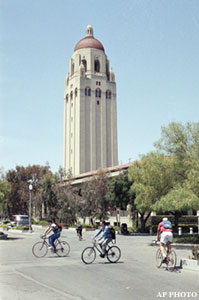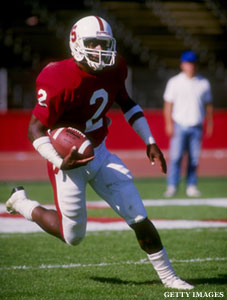Sometimes people see only what they want to see. Their vision is fixed and their truth rigid. For instance, some people think all student-athletes should be painted with one brush. And no amount of evidence, discussion or exposure, will lead them to think otherwise. This was driven home during my freshman year at Stanford. It was dinner time at the dining hall.
It should be noted that with the exception of my senior year, the football team didn’t have a bona fide "Training Table," meaning a separate building where "better" food was served. Before Denny Green’s arrival, the official training table consisted of only dinner (not three meals) which was served in the Wilbur Hall dining room. This was the same place where other students dined, so after practice, it was customary for the football team to eat whatever everyone else ate that night.

This one evening, the fare consisted of roast beef, potatoes and carrots. But after they ran out of carrots, the late arrivals -- mostly the football team -- were offered peas. Tray in hand, I was next in line to get served when some guy, a tall kid with brown curly hair exclaimed, "Oh, they get peas?"
I laughed out loud. The way he spoke, the "Oh,” an exaggerated long "o" executed as a gasp, implied that we were receiving a special vegetable, a magic legume, perhaps a distant cousin of the beans that led to Jack’s wondrous beanstalk. So I looked down at the peas, to make sure I wasn’t missing something. Were there little baby onions tossed in for flavor and appearance? Perhaps they weren’t peas at all. Perhaps it was edamame, a staple at your neighborhood Japanese restaurant, but surely a rarity at even your finest training table. I looked closely, but all I saw was garden-variety peas, most likely of the Green Giant brand, once frozen and now in a big old steaming silver bin.
Today, there’s another view of the Stanford athlete.
Today’s story is that Stanford athletes were offered easy classes from which the student body at large was deprived. A group called California Watch has uncovered a list of courses that are allegedly guaranteed to get A’s for the Stanford jock. This list was available only in the student-athlete resource center.
The supposed scandal here is that not all of the classes on this top secret list satisfy "academic requirements." Problem is, the schedule is dominated by courses that do indeed satisfy those requirements -- courses that I’m quite certain are populated by the Stanford student body. Like Global Entrepreneurial Marketing, Calculus, Media, Ethics, and Responsibilities, and Political Science 2: Intro to American National Government.
But this "investigative report" centers on classes like "Social Dances of North America" and a drama class called "Beginning Improvising." There’s a word for such classes: Electives.
In a climate where the popular trend is to demythologize the American athlete, this latest story is quite a reach.
See, on every college campus, there is a basic curriculum that satisfies the university’s general requirements, and another which satisfies a student’s major. Then there are electives -- classes you take out of personal interest or curiosity. These courses usually have nothing to do with your major, and may have nothing to do with career aspirations, but they reflect the spirit of higher learning in the sense such courses could lead to a more rounded person. Some may be deemed more "academically rigorous" than others, but there’s always a purpose.
For instance, you could walk into an African American Studies class and find some white kids scattered among the black faces. Or you could walk into a lecture on feminist studies and find a few ambitious (albeit nervous) men hoping to gain some much needed insight on the female mystique.
I think a lot of people would benefit from this sort of exposure. It’s better to take these courses when you’re young, energetic and still clutching some straws of idealism. In the corporate world, such classes are offered under the guise of "sensitivity training." But they’re usually metered out as a punishment and tend not to have such a positive impact on those who attend.

But that’s not the most interesting part of the course schedule. There was one class on the controversial list, Poetry and Poetics, which reminded me of days gone by. I took that course the same time I took Seventeenth Century Poetry. Both were required of English majors at the time, and were the last courses I needed to complete the degree. Problem was, the only time they were available was in the afternoon of fall quarter, which was dominated by film study and practice. But when both courses were finally available in the winter of my senior year, I had another dilemma: The first two weeks of winter quarter coincided with the Hula Bowl and the Senior Bowl, both of which I was planning to attend.
I sought guidance from my academic advisor. He wrote a letter to the professor of Seventeenth Century Poetry, informing her of my situation, and suggested I meet with her before I left. All I remember from that meeting was this one statement. She told me, "It sure was nice of your advisor to write that letter on your behalf."
I remember thinking, "Well, that is kind of his job, isn’t it?"
But I said nothing, offering just a smiling agreement. I feared she had some preconceived notions about athletes and I wasn’t in position to disabuse her of them right then.
Shortly after my return from Mobile, Alabama, (where my North team beat the South team, 41-0) I returned to a class where I was introduced to baroque literature. This is the period right after the Renaissance, an era that was characterized by outrageous, sometimes grotesque imagery in architecture, literature and art.
Seventeenth Century Poetry was a seminar class, where every student had to conduct his or her own presentation. A poem by Richard Crashaw, called “On the Wounds of Our Crucified Lord” became the subject of my seminar. It was a poem about the crucifixion, more specifically the Sacrament of the Eucharist, and how the "body of Christ" could be literally consumed.
Thy hunger feeles not what he eates:
Hee'l have his Teat e're long (a bloody one)
The Mother them must suck the Son.
From the wound in Christ’s torso, from where He had been stabbed, fell a long piece of bloody flesh. The author suggested that perhaps Mary should suckle from this wound the same way her Son had been suckled on her teat. I know, kind of nasty, huh? But that was the point, I argued to the class. He took the most sacred cow in Christianity and turned it on its head. His take was that if Mary, and all the other disciples of Christ, wanted to partake of His Spirit, then they should literally taste the blood of his wounds. I opined that I wasn’t sure if Crashaw actually meant everything he said, but seemed he wanted to shake up the Church, a bit. He was in essence, your seventeenth century shock jock.
I got a B in the class.
So my professor wasn’t like that guy from the dining hall. She was malleable and capable of extended vision. The guy from the dining hall wasn’t. He saw something else. He saw something unattainable -– a vegetable, a class schedule, an experience, to which he should have been entitled, but from which he was maliciously deprived. That was his reality. It’s like that for some people.
I’m not saying I was a great student. I wasn’t. But the written word spoke to me. And 20 years later, turns out there was a practical application: Here I am writing.
Not bad for a pea-eater.
-- Alan Grant played cornerback for the Colts, 49ers, Bengals and Redskins. He is the author of "Return to Glory:" Inside Tyrone Willingham's Amazing First Season at Notre Dame.




